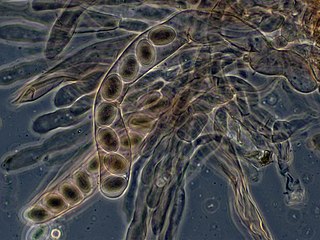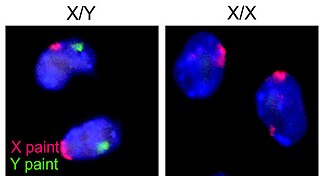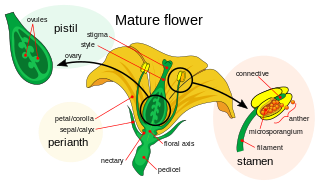Reproduction via spores
Reproductive spores are generally the result of cell division, most commonly meiosis (e.g. in plant sporophytes). Sporic meiosis is needed to complete the sexual life cycle of the organisms using it.
In some cases, sporogenesis occurs via mitosis (e.g. in some fungi and algae). Mitotic sporogenesis is a form of asexual reproduction. Examples are the conidial fungi Aspergillus and Penicillium , for which mitospore formation appears to be the primary mode of reproduction. Other fungi, such as ascomycetes, utilize both mitotic and meiotic spores. The red alga Polysiphonia alternates between mitotic and meiotic sporogenesis and both processes are required to complete its complex reproductive life cycle.
In the case of dormant spores in eukaryotes, sporogenesis often occurs as a result of fertilization or karyogamy forming a diploid spore equivalent to a zygote. Therefore, zygospores are the result of sexual reproduction.
Reproduction via spores involves the spreading of the spores by water or air. Algae and some fungi (chytrids) often use motile zoospores that can swim to new locations before developing into sessile organisms. Airborne spores are obvious in fungi, for example when they are released from puffballs. Other fungi have more active spore dispersal mechanisms. For example, the fungus Pilobolus can shoot its sporangia towards light. Plant spores designed for dispersal are also referred to as diaspores. Plant spores are most obvious in the reproduction of ferns and mosses. However, they also exist in flowering plants where they develop hidden inside the flower. For example, the pollen grains of flowering plants develop out of microspores produced in the anthers.
Reproductive spores grow into multicellular haploid individuals or sporelings. In heterosporous organisms, two types of spores exist: microspores give rise to males and megaspores to females. In homosporous organisms, all spores look alike and grow into individuals carrying reproductive parts of both genders.
Sporogenesis occurs in reproductive structures termed sporangia. The process involves sporogenous cells (sporocytes, also called spore mother cells) undergoing cell division to give rise to spores.
In meiotic sporogenesis, a diploid spore mother cell within the sporangium undergoes meiosis, producing a tetrad of haploid spores. In organisms that are heterosporous, two types of spores occur: Microsporangia produce male microspores, and megasporangia produce female megaspores. In megasporogenesis, often three of the four spores degenerate after meiosis, whereas in microsporogenesis all four microspores survive.
In gymnosperms, such as conifers, microspores are produced through meiosis from microsporocytes in microstrobili or male cones. In flowering plants, microspores are produced in the anthers of flowers. Each anther contains four pollen sacs, which contain the microsporocytes. After meiosis, each microspore undergoes mitotic cell division, giving rise to multicellular pollen grains (six nuclei in gymnosperms, three nuclei in flowering plants).
Megasporogenesis occurs in megastrobili in conifers (for example a pine cone) and inside the ovule in the flowers of flowering plants. A megasporocyte inside a megasporangium or ovule undergoes meiosis, producing four megaspores. Only one is a functional megaspore whereas the others stay dysfunctional or degenerate. The megaspore undergoes several mitotic divisions to develop into a female gametophyte (for example the seven-cell/eight-nuclei embryo sac in flowering plants).
Some fungi and algae produce mitospores through mitotic cell division within a sporangium. In fungi, such mitospores are referred to as conidia.
Some algae, and fungi form resting spores made to survive unfavorable conditions. Typically, changes in the environment from favorable to unfavorable growing conditions will trigger a switch from asexual reproduction to sexual reproduction in these organisms. The resulting spores are protected through the formation of a thick cell wall and can withstand harsh conditions such as drought or extreme temperatures. Examples are chlamydospores, teliospores, zygospores, and myxospores. Similar survival structures produced in some bacteria are known as endospores.
Chlamydospores are generally multicellular, asexual structures. Teliospores are a form of chlamydospore produced through the fusion of cells or hyphae where the nuclei of the fused cells stay separate. These nuclei undergo karyogamy and meiosis upon germination of the spore.
Zygospores are formed in certain fungi (zygomycota, for example Rhizopus ) and some algae (for example Chlamydomonas ). The zygospore forms through the isogamic fusion of two cells (motile single cells in Chlamydomonas) or sexual conjugation between two hyphae (in zygomycota). Plasmogamy is followed by karyogamy, therefore zygospores are diploid (zygotes). They will undergo zygotic meiosis upon germinating.
In oomycetes, the zygote forms through the fertilization of an egg cell with a sperm nucleus and enters a resting stage as a diploid, thick-walled oospore. The germinating oospore undergoes mitosis and gives rise to diploid hyphae which reproduce asexually via mitotic zoospores as long as conditions are favorable.
In diatoms, fertilization gives rise to a zygote termed auxospore. Besides sexual reproduction and as a resting stage, the function of an auxospore is the restoration of the original cell size, as diatoms get progressively smaller during mitotic cell division. Auxospores divide by mitosis.
The term sporogenesis can also refer to endospore formation in bacteria, which allows the cells to survive unfavorable conditions. Endospores are not reproductive structures and their formation does not require cell fusion or division. Instead, they form through the production of an encapsulating spore coat within the spore-forming cell.

Asexual reproduction is a type of reproduction that does not involve the fusion of gametes or change in the number of chromosomes. The offspring that arise by asexual reproduction from either unicellular or multicellular organisms inherit the full set of genes of their single parent and thus the newly created individual is genetically and physically similar to the parent or an exact clone of the parent. Asexual reproduction is the primary form of reproduction for single-celled organisms such as archaea and bacteria. Many eukaryotic organisms including plants, animals, and fungi can also reproduce asexually. In vertebrates, the most common form of asexual reproduction is parthenogenesis, which is typically used as an alternative to sexual reproduction in times when reproductive opportunities are limited. Some monitor lizards, including Komodo dragons, can reproduce asexually.

A gametophyte is one of the two alternating multicellular phases in the life cycles of plants and algae. It is a haploid multicellular organism that develops from a haploid spore that has one set of chromosomes. The gametophyte is the sexual phase in the life cycle of plants and algae. It develops sex organs that produce gametes, haploid sex cells that participate in fertilization to form a diploid zygote which has a double set of chromosomes. Cell division of the zygote results in a new diploid multicellular organism, the second stage in the life cycle known as the sporophyte. The sporophyte can produce haploid spores by meiosis that on germination produce a new generation of gametophytes.

A zygote is a eukaryotic cell formed by a fertilization event between two gametes. The zygote's genome is a combination of the DNA in each gamete, and contains all of the genetic information of a new individual organism. The sexual fusion of haploid cells is called karyogamy, the result of which is the formation of a diploid cell called the zygote or zygospore.

Ascomycota is a phylum of the kingdom Fungi that, together with the Basidiomycota, forms the subkingdom Dikarya. Its members are commonly known as the sac fungi or ascomycetes. It is the largest phylum of Fungi, with over 64,000 species. The defining feature of this fungal group is the "ascus", a microscopic sexual structure in which nonmotile spores, called ascospores, are formed. However, some species of Ascomycota are asexual and thus do not form asci or ascospores. Familiar examples of sac fungi include morels, truffles, brewers' and bakers' yeast, dead man's fingers, and cup fungi. The fungal symbionts in the majority of lichens such as Cladonia belong to the Ascomycota.

In biology, a spore is a unit of sexual or asexual reproduction that may be adapted for dispersal and for survival, often for extended periods of time, in unfavourable conditions. Spores form part of the life cycles of many plants, algae, fungi and protozoa. They were thought to have appeared as early as the mid-late Ordovician period as an adaptation of early land plants.
A sporangium ; pl.: sporangia) is an enclosure in which spores are formed. It can be composed of a single cell or can be multicellular. Virtually all plants, fungi, and many other groups form sporangia at some point in their life cycle. Sporangia can produce spores by mitosis, but in land plants and many fungi, sporangia produce genetically distinct haploid spores by meiosis.

Alternation of generations is the predominant type of life cycle in plants and algae. In plants both phases are multicellular: the haploid sexual phase – the gametophyte – alternates with a diploid asexual phase – the sporophyte.

Zygomycota, or zygote fungi, is a former division or phylum of the kingdom Fungi. The members are now part of two phyla: the Mucoromycota and Zoopagomycota. Approximately 1060 species are known. They are mostly terrestrial in habitat, living in soil or on decaying plant or animal material. Some are parasites of plants, insects, and small animals, while others form symbiotic relationships with plants. Zygomycete hyphae may be coenocytic, forming septa only where gametes are formed or to wall off dead hyphae. Zygomycota is no longer recognised as it was not believed to be truly monophyletic.

An ascus is the sexual spore-bearing cell produced in ascomycete fungi. Each ascus usually contains eight ascospores, produced by meiosis followed, in most species, by a mitotic cell division. However, asci in some genera or species can occur in numbers of one, two, four, or multiples of four. In a few cases, the ascospores can bud off conidia that may fill the asci with hundreds of conidia, or the ascospores may fragment, e.g. some Cordyceps, also filling the asci with smaller cells. Ascospores are nonmotile, usually single celled, but not infrequently may be coenocytic, and in some cases coenocytic in multiple planes. Mitotic divisions within the developing spores populate each resulting cell in septate ascospores with nuclei. The term ocular chamber, or oculus, refers to the epiplasm that is surrounded by the "bourrelet".

Gametogenesis is a biological process by which diploid or haploid precursor cells undergo cell division and differentiation to form mature haploid gametes. Depending on the biological life cycle of the organism, gametogenesis occurs by meiotic division of diploid gametocytes into various gametes, or by mitosis. For example, plants produce gametes through mitosis in gametophytes. The gametophytes grow from haploid spores after sporic meiosis. The existence of a multicellular, haploid phase in the life cycle between meiosis and gametogenesis is also referred to as alternation of generations.

In biology, a biological life cycle is a series of stages of the life of an organism, that begins as a zygote, often in an egg, and concludes as an adult that reproduces, producing an offspring in the form of a new zygote which then itself goes through the same series of stages, the process repeating in a cyclic fashion.

In seed plants, the ovule is the structure that gives rise to and contains the female reproductive cells. It consists of three parts: the integument, forming its outer layer, the nucellus, and the female gametophyte in its center. The female gametophyte — specifically termed a megagametophyte — is also called the embryo sac in angiosperms. The megagametophyte produces an egg cell for the purpose of fertilization. The ovule is a small structure present in the ovary. It is attached to the placenta by a stalk called a funicle. The funicle provides nourishment to the ovule. On the basis of the relative position of micropyle, body of the ovule, chalaza and funicle, there are six types of ovules.

Karyogamy is the final step in the process of fusing together two haploid eukaryotic cells, and refers specifically to the fusion of the two nuclei. Before karyogamy, each haploid cell has one complete copy of the organism's genome. In order for karyogamy to occur, the cell membrane and cytoplasm of each cell must fuse with the other in a process known as plasmogamy. Once within the joined cell membrane, the nuclei are referred to as pronuclei. Once the cell membranes, cytoplasm, and pronuclei fuse, the resulting single cell is diploid, containing two copies of the genome. This diploid cell, called a zygote or zygospore can then enter meiosis, or continue to divide by mitosis. Mammalian fertilization uses a comparable process to combine haploid sperm and egg cells (gametes) to create a diploid fertilized egg.
A zygospore is a diploid reproductive stage in the life cycle of many fungi and protists. Zygospores are created by the nuclear fusion of haploid cells. In fungi, zygospores are formed in zygosporangia after the fusion of specialized budding structures, from mycelia of the same or different mating types, and may be chlamydospores. In many eukaryotic algae, including many species of the Chlorophyta, zygospores are formed by the fusion of unicellular gametes of different mating types.

Double fertilization or double fertilisation is a complex fertilization mechanism of angiosperms. This process involves the fusion of a female gametophyte or megagametophyte, also called the embryonic sac, with two male gametes (sperm). It begins when a pollen grain adheres to the stigmatic surface of the carpel, the female reproductive structure of angiosperm flowers. The pollen grain begins to germinate, forming a pollen tube that penetrates and extends down through the style toward the ovary as it follows chemical signals released by the egg. The tip of the pollen tube then enters the ovary by penetrating through the micropyle opening in the ovule, and releases two sperm into the embryonic sac (megagametophyte).

The Mucorales is the largest and best-studied order of zygomycete fungi. Members of this order are sometimes called pin molds. The term mucormycosis is now preferred for infections caused by molds belonging to the order Mucorales.

Megaspores, also called macrospores, are a type of spore that is present in heterosporous plants. These plants have two spore types, megaspores and microspores. Generally speaking, the megaspore, or large spore, germinates into a female gametophyte, which produces egg cells. These are fertilized by sperm produced by the male gametophyte developing from the microspore. Heterosporous plants include seed plants, water ferns (Salviniales), spikemosses (Selaginellaceae) and quillworts (Isoetaceae).
Plant reproduction is the production of new offspring in plants, which can be accomplished by sexual or asexual reproduction. Sexual reproduction produces offspring by the fusion of gametes, resulting in offspring genetically different from either parent. Asexual reproduction produces new individuals without the fusion of gametes, resulting in clonal plants that are genetically identical to the parent plant and each other, unless mutations occur.

A megaspore mother cell, or megasporocyte, is a diploid cell in plants in which meiosis will occur, resulting in the production of four haploid megaspores. At least one of the spores develop into haploid female gametophytes, the megagametophytes. The megaspore mother cell arises within the megasporangium tissue.

Sexual reproduction is a type of reproduction that involves a complex life cycle in which a gamete with a single set of chromosomes combines with another gamete to produce a zygote that develops into an organism composed of cells with two sets of chromosomes (diploid). This is typical in animals, though the number of chromosome sets and how that number changes in sexual reproduction varies, especially among plants, fungi, and other eukaryotes.
















